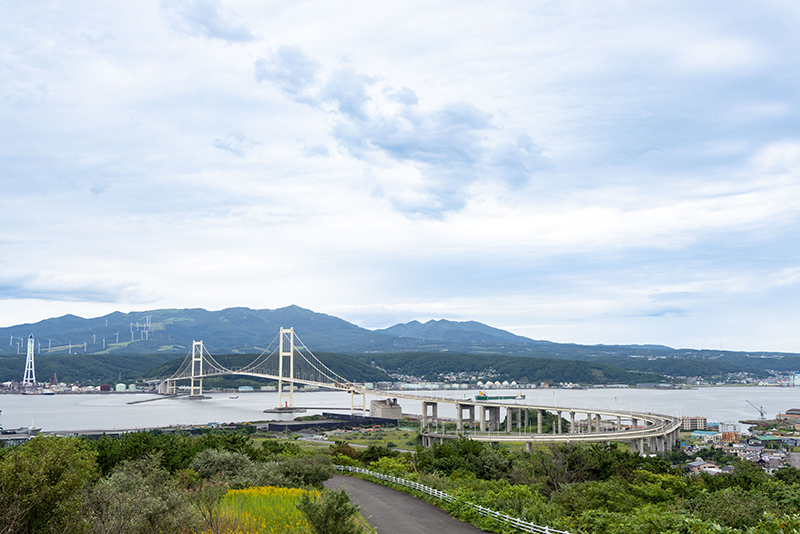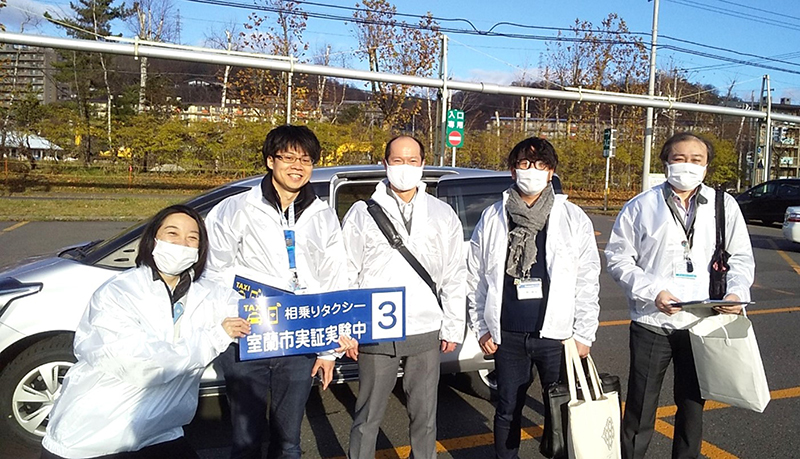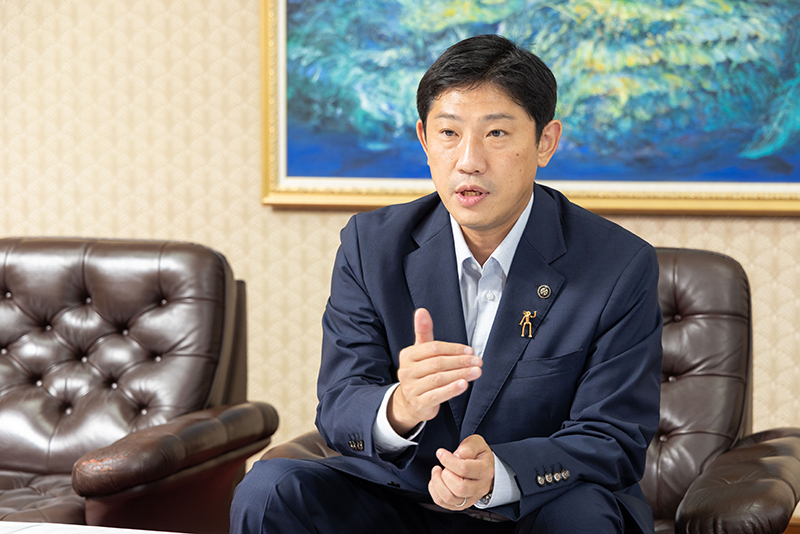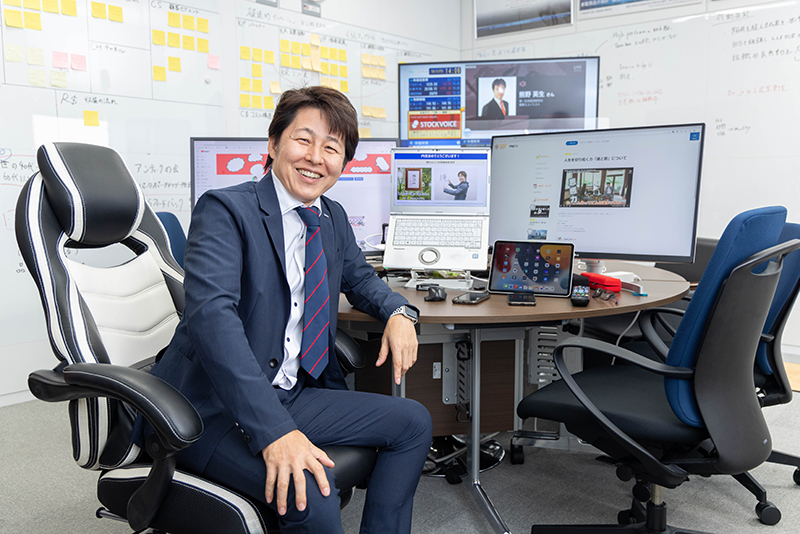Newsroom
Panasonic’s MaaS Project in Muroran City, Hokkaido

Panasonic has long been dedicated to making a difference in society. In 2018, Panasonic ITS Co., Ltd.—a software and hardware design and development company under Panasonic Automotive Systems Co., Ltd.—came up with a Mobility as a Service (MaaS) project for Muroran City, Hokkaido. To bring this project to life, Panasonic ITS opened an office in Muroran City and is now conducting a demonstration experiment with the cooperation of the local government as well as universities and various regional companies.
The goal of the MaaS concept is to optimize mobility as a single service that can be used efficiently through various means of transportation in conjunction with information and communication technology. Most MaaS projects are developed for urban areas where a large number of users and a certain level of profit can be expected. Panasonic ITS, however, chose instead to develop a MaaS system in a rural area with relatively fewer users. This is because, according to Panasonic ITS, such rural areas with few transportation options and an aging population are where MaaS is most needed.
The members involved in this project fervently believe that Panasonic must look to develop services in areas where such services are truly needed in accordance with its corporate motto of “Making a difference in society.” This ambitious project is taking shape in southern Hokkaido.
Various Issues Faced by Local Municipalities




Similar to other regional cities, trains and buses operate only infrequently in Muroran City, making private vehicles essential for mobility. At the same time, the rapidly aging population means more and more residents are finding it difficult to drive, further hindering their mobility. Local taxi, bus, and garbage collection companies are also faced with a variety of challenges including aging drivers and fewer users due to a shrinking population, resulting in decreased profits.
Despite these issues, the Muroran MaaS project has helped reduce fare amounts paid by users and also shortened travel times through an app for taxi ride-sharing and collaboration functionality that brings together express bus and taxi services. This increased flexibility in mobility has been greatly appreciated by residents, particularly the elderly who are unable to drive on their own. The navigation system specially designed for this project has also helped improve the efficiency of garbage collection services including by proposing optimized collection routes.Through this MaaS demonstration experiment, Panasonic ITS has shown how it can play a role in finding solutions to a variety of issues facing Muroran City.
Panasonic: Offering Solutions to Various Unresolved Issues

The small, elite team at Panasonic ITS’s Muroran office handling the project includes 5 members, and the development leader, Mr. Sato, is a Hokkaido native. “Our goal was to create a business that could deliver our ideas directly to the users,” he said.
“After joining Panasonic ITS, I worked on business-to-business relations between companies, but I always had a strong desire to hear directly from the users. When volunteers from within the company got together to come up with a new business project, I decided to join. I discussed with other members how Panasonic manufactures products that help people in the car, and that it would be good to also help people outside their car, too. We decided that those living in rural areas had the most trouble with mobility. However, this is a difficult area for companies to invest in because it’s difficult to make a profit. This led us to the conclusion that, because of its corporate policy of making a difference in society, Panasonic should focus on developing MaaS systems in rural areas. With its aging population and limited transportation options, we decided that Muroran City was an area with a significant need for a MaaS project and a good place to launch a demonstration experiment.”

The idea of prioritizing making a difference in society is also highlighted in Mr. Sato’s philosophy as a developer. In developing the Muroran MaaS project, his goal was to create a system specifically tailored to Muroran City.
“When it comes to ensuring efficiency, the best method is to create a single system that can be mass-produced, and many MaaS services are developed in this way,” Mr. Sato says. “Instead, we decided that the system in Muroran should be optimized for Muroran, and other projects in other cities should be optimized accordingly. The Muroran MaaS project was based on an axial system, but in terms of how users interact with the service, we wanted to take it further and create a tailor-made, community-based system.”
Because the business would be focused on Muroran City, having an office in the city itself allowed project members to get valuable daily feedback from actual residents that use the service. The resounding gratitude from users soon became encouragement to continue improving and expanding the system.

Working Together with Local Government Officials

But Mr. Sato and his fellow Panasonic ITS employees were not the only ones working on the Muroran MaaS project. A separate 5-member team made up of Muroran City Hall employees also played an essential role in the project by helping to bring the community and Panasonic together. These individuals worked tirelessly from the project’s outset to build relationships with local companies.
“When development first began, Panasonic ITS’s presence in Muroran City was not widely felt, and establishing relationships with local businesses was difficult,” explains Mr. Ogasawara, a Muroran City Hall official and member of the Muroran MaaS project team. To ensure a better understanding of the project, the members of the City Hall team made numerous visits to various companies.

Mr. Ogasawara says that, as the development leader, Mr. Sato was a great help during this promotional phase. “At City Hall, my main focus was to find ways to keep situations from getting worse than they should be,” Mr. Ogasawara recalls. “But Mr. Sato was always looking for ways to make things better. I not only realized that this was one of the main differences between a private company and City Hall, but I was also encouraged by the willingness to change anything to make situations better. I truly believe this project could not have worked if it were not for Mr. Sato.”
“While there are some aspects that can still be improved, there are many things that we can still do going forward. Although City Hall might not have the power to solve a variety of community issues on its own, working together with Panasonic to develop new initiatives opens the door to a lot of possibilities,” Mr. Ogasawara adds enthusiastically.

Mr. Aoyama, mayor of Muroran City, had this to add: “I have been approached by a lot of different companies, but only Panasonic ITS had the grand goal of solving the many issues faced by local municipalities across Japan like Muroran City, and I sympathized with that goal.”
Mayor Aoyama, who is also a Doctor of Engineering, says he has long been enamored by engineering’s mission of using technology to overcome society’s issues. This was one of the main reasons he decided to work with Panasonic ITS to promote the MaaS project.

“I hope to use the navigation system to help solve a variety of social issues,” Mayor Aoyama says. “By facing the same challenges that local municipalities across Japan will be forced to face in the future, Muroran City can get ahead of the game and become a leader in how to solve these problems. Muroran is home to an engineering university, and the city has long been recognized for its focus on manufacturing, so our citizens have a good understanding when it comes to science and technology. I believe that its history as a city of industry makes Muroran the perfect place to discover solutions to a wide variety of issues through technology.”
“Panasonic ITS represents Panasonic, a company that is dedicated to finding solutions to various social issues,” Mayor Aoyama adds. “Working with Panasonic to develop these kinds of solutions can lead to various improvements in the way of life not only in Muroran but also other cities across Japan, and these improvements have the power to bring happiness to everyone. I am proud to be a part of that initiative, and I look forward to working with Panasonic in the future.” This collaborative project between Panasonic and Muroran City will help to institute major changes in Japan.
Furthering the Development of Personnel

So what is it that makes social contributions like the Muroran MaaS project so important for corporate management? To answer that question, Mr. Tanabe—President of Panasonic ITS—explains his goals in this way:
“When it comes to our projects for making a difference in society, I believe that our employees will benefit through valuable growth. Employees tend to be significantly more motivated if the projects they are working on can help society. And motivation is an essential factor in personnel development. Being able to do today what you couldn’t do yesterday not only significantly increases happiness but also drives further growth. Every member of the Muroran MaaS project has shown tremendous enthusiasm and energy in their work. That is one of the main reasons we are working toward commercializing this project.”
“Panasonic’s founder Konosuke Matsushita said, ‘Create people before creating products,’ and that has been the foundation of my way of thinking,” Mr. Tanabe adds. “Developing personnel will invariably lead to future development of the company. Of course, we must also strive to make a profit even as we continue to serve society, but in the short-term perspective, a company that focuses solely on profit and doesn’t take the time for the development of personnel cannot continue to grow.”
However, the Muroran MaaS project is only one part of Panasonic ITS’s plan for providing a platform that can revitalize communities by leveraging local strengths with mobility as the centerpiece. Panasonic ITS hopes that this demonstration experiment will allow the company to establish a business model capable of benefiting the lives of residents, and that this Muroran model can serve as an example for other communities. Going forward, Panasonic ITS will remain dedicated to undertaking various new businesses with consideration for long-term management while also keeping personnel development in mind. The project in Muroran highlights Panasonic’s core belief of making a difference in society by putting people first and will serve as a building block for future initiatives.


